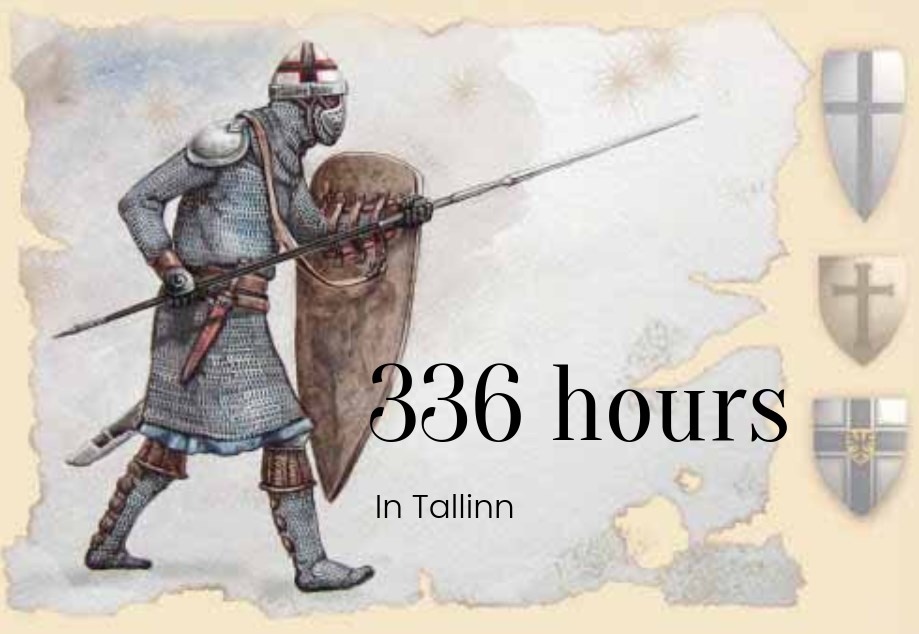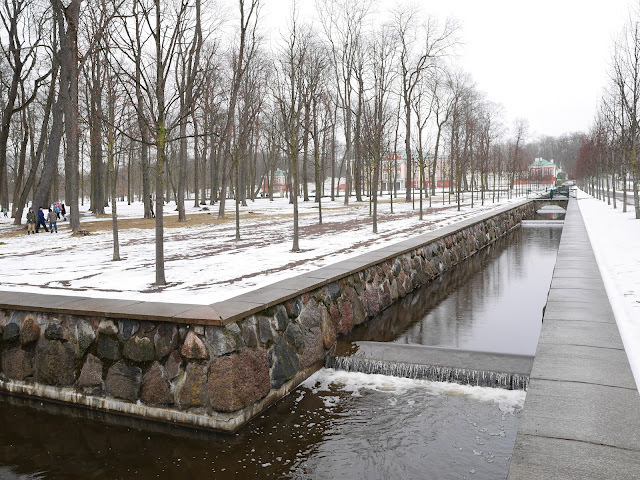Out of oblivion
My daily plans are frequently blown up by making stupid tourist mistakes, like impulsively jumping on a tram because I think I know where it's headed, only to wind up three miles from where I intended. But it's fine. There are no consequences, and such missteps can create a wonderful serendipity.
On the northeastern outskirts is Kadriorg Park, established by Russian emperor Peter the Great, who conquered Tallinn in 1710. Not much is happening here on this bracing day. Just a lot of little kids rolling around in the snow doing kid stuff.
My wanderings from here take me to the seaside church of St. Simeon and St. Anne, built by Russian mariners in 1752. Like the Alexander Nevsky Church, it's Orthodox, so I figured both fell under the jurisdiction of the ecumenical patriarch in Istanbul, but there was a schism in 2018. Estonia is a fire hose of history.
At this time of day, office workers in greater Tallinn are rushing to and from lunch. This is about the maximum number of people I have seen in an outdoor area in two weeks.
A monument marking the revolution of 1905, which was an outgrowth of the uprising in Russia the same year. Here it manifested with worker strikes, demands for press freedoms, universal suffrage ― the usual stuff.
So who was running things in Estonia back then? This is one of the knottiest historical puzzles I have encountered here. Estonians call it a revolution, but what was the established order that was being overturned?
As with everything in this part of the world ... it's complicated. Estonia was part of the tsarist Russian empire, but it was ethnic Germans who ran the legal system, the colleges, the Lutheran Church. So was it really a revolt against educated German immigrants? That is my incomplete understanding, and I'm sticking with it until I gain a more complete picture.
Like a lot of European countries that have been knocked around, there can be any number of "independence" and "liberation" days. You climb out from under somebody's boot heel only to be crushed again.
This thought-provoking little wedge of a museum further reels the mind.
It tells stories of the two waves of Stalin-ordered expulsions carried out in Estonia (1941 and 1949). The most dangerous place to be during these purges is at the top of the nomenklatura. Just about every politician and military officer in the country was arrested and more than 2,000 were executed. Another 10,000 Estonians, mostly women and children, were shipped off to Siberia. There was no due process, of course ― they were simply deemed undesirable anti-Soviet elements and removed. Half of them died in their first year after being rousted from their Estonian beds.
Ordinary citizens.
Seeing what was going on, others fled on small boats on the Baltic Sea, taking only a few items with them, expecting the occupation to be brief. Instead, as the USSR tightened its regime of terror on the Baltics, they had to spend years in refugee camps, primarily in Germany and Sweden.
To a degree, the museum seems aimed at schoolchildren, which is fine and laudable, but the result can be patronizing. "If you had only a minute to leave your home, what would you take with you?" this exhibit asks. Fuck if I know. Look, I'm horrified this continent went through these convulsions over and over and am capable of generating these reflections on my own. I don't need the prompt.
While Estonians were enslaved on collective farms in Siberia, Stalin proclaimed to be fixing Estonia's agricultural situation in reprehensible propaganda posters like this one.
"Would you have resisted the occupation, or would you have gotten back to work?" the narrator intones through my headset. This guy again.
I'd like to think I could muster the righteous initiative to join the Forest Brothers, who waged guerrilla war for years against their Soviet occupiers. But by the early 1950s they had been wiped out and achieved nothing, so was it worth it? If the idea of this museum is to make me uncomfortable, it has done its job.
This is a nice museum, but to borrow from the language of product developers, its UX leaves a little to be desired. It's a small place chopped up into a lot of rooms, so claustrophobia is an isssue. And it's unintelligible without the aid of these damned devices ― one more thing to carry around and fiddle with.
As the promise of perestroika bubbled in the 1980s and Soviet-era thought restrictions melted away, Estonians were faced with a new problem. Freedom is not a gift; it's a prickly concept. One person's freedom can limit another's. The ideas of free expression, entrepreneurship, social justice ― not to mention the responsibilities to one's self and to others ― are in constant conflict. That will never change.
More salient: Which freedoms are we willing to fight for? When are we willing to agree to restrictions? When is it too early to act? When is it too late?
Boris Yeltsin ceded Estonia in 1991.
Vabamu Museum of Occupations and Freedom
Toompea 8
Wed.-Sun. 11 a.m.-6 p.m.
11 euros












